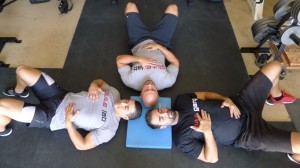I've written before about the importance of breathing on this blog. But a recent session with a client caused me to think it may be worth revisiting. The session I am referring to was with a young client who was doing a vertical load of resistance exercises. This basically means he would do one exercise, move to a different second exercise and finish with a third exercise before taking a rest. This is different from horizontal loading, which is seen in many big box gyms, and involves doing a set of a particular exercise, resting for the prescribed amount of time, then repeating this to complete all the sets before moving on to the next part of the training session. Not only does vertical loading allow for greater workout density it also allows for greater intensity. You can train more intensely because you have more time from one lift until you repeat that same lift again. There are two other exercises plus a rest break before completing the next set of the same exercise. But this post isn't about program design. Instead it's to illustrate the importance of proper breathing during training. Now as you can imagine doing a workout of this type your heart rate will begin to climb. And if you are a little bit deconditioned, tired, under-fueled, dehydrated, stressed or coming down with a cold your heart may have to work a little harder than normal to do the task at hand. And as your heart rate climbs and you try to push yourself you may find you aren't recovering adequately to maintain the intensity and pace of your workout. Since safety precedes results you need an option here. Here's what we did for this client that helped him complete not only this set but the rest of...
Stand Tall for Better Recovery
- Chris Collins
- Fitness
- Training
- Work-Out Recovery
- 1738 Hits
- 0 Comments
-
One of the great things about coaching is that there are plenty of opportunities to train. We never have an excuse for access to equipment. While it's nice to have access to kettle bells, Olympic platforms and anything that makes a session more enjoyable the truth is all we need is gravity for an effective workout. But besides that we're always getting exposed to new training methodologies and research. And so this can become our lab. This is the place we test our theories, see what works, what doesn't and how to make any changes if necessary. And just as the best part of our job is the people we get to work with this place is great in that we can usually find another coach to rope into a training session. Megan, Kayla, Graeme and Jordy all place a high value on training and are always up for the challenge as well. Recently when training with Megan and Kayla I noticed they were doing something at the end of each set. And it's something most of us do usually out of habit. [caption id="attachment_4253" align="aligncenter" width="263"] Kayla or Megan? Take your pick If this were a live presentation and I asked for a show of hands 'who bends over and puts there hands on their knees to recover?' almost 100% of the room would be reaching skyward. But there's a couple of problems with this. First of all let's take a look at what an ideal posture should be. And compare this to the common forward head posture many people have. [caption id="attachment_4254" align="aligncenter" width="300"] Ideal or forward head posture Now if you look at the bottom arrow of the picture on the right you can imagine this is close to where the pelvis would sit. The picture on the...

